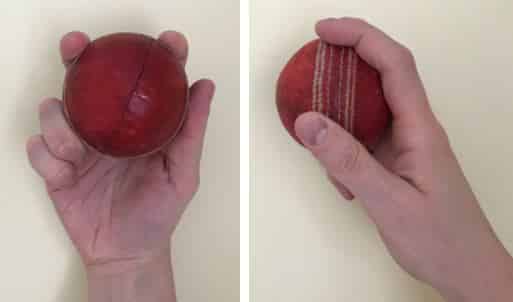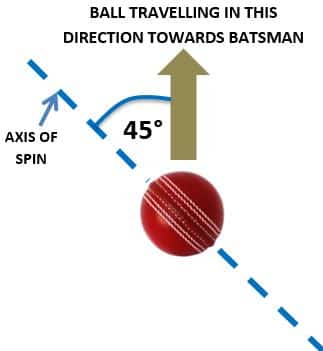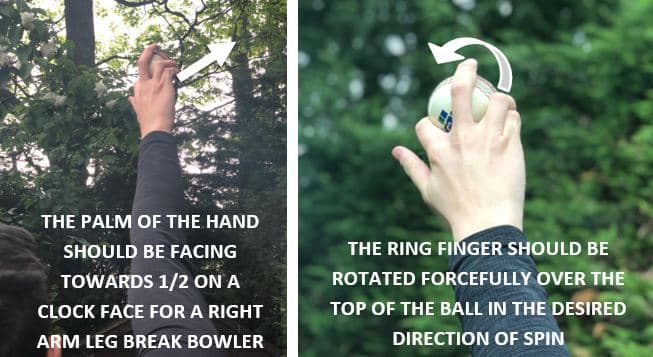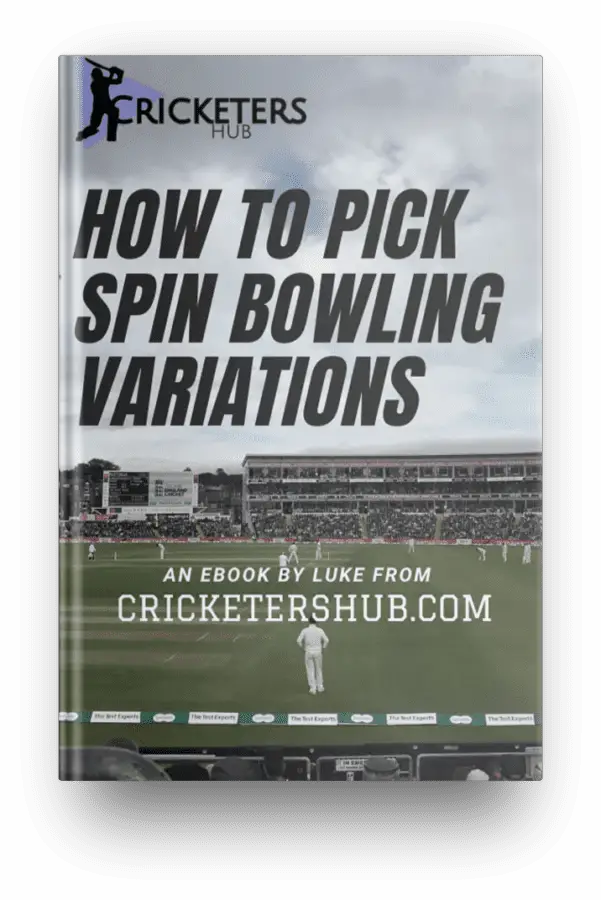Leg break bowling is one of the hardest cricket skills to master. Getting the ball to spin is one of the most challenging parts of it, but many bowlers also struggle with their accuracy and speeds when bowling these deliveries! A bowler who can master these three aspects of leg break bowling should be well on their way to success in the game of cricket…and in this post I’m going to teach you how to get started!
So, what does the perfect leg break look like? Many people think that the ball Shane Warne bowled to Mike Gatting in 1993 (now referred to as ‘The Gatting Ball’) is an example of the perfect leg break. It had everything – pace, drift, accuracy and plenty of spin. Here is a link if you’d like to watch it before you continue reading! See it as a little something to inspire you! If you currently play cricket for a club side, or even if you haven’t joined a team yet, there’s plenty of things you get to work on straight away to improve your leg break bowling. You can learn to bowl the perfect leg break delivery by focusing on the following areas:
- The Grip
- The Run-Up
- How The Spin Is Applied To The Leg Break
- Where To Pitch The Leg Break
- The Speed Of The Bowling
I’m going to take you through all those one by one and explain what you should be trying to achieve. But just briefly, before we begin…if you’re reading this and you’re not sure what leg break bowling is, then I wrote this post breaking down the different types of spin bowlers that exist in cricket. It’s a good place to start if you’re relatively new to the sport!
What Grip Is Used When Bowling The Leg Break?
The grip needed for the leg break is commonly referred to as the ‘Two up, two down’ grip. This means that two fingers of your bowling hand (index and middle fingers) will be on top of the ball with the seam running across them, whilst the ring finger and little finger will sit alongside the ball for support. The two fingers on top of the ball should be a comfortable distance apart – not too close together, but not so far apart that they are being stretched unnaturally. As the thumb is not directly involved in the process of applying spin, it is primarily used to support the underneath of the ball.
Shane Warne is the greatest leg break bowler ever to put on a pair of whites. One thing that I remember him saying about the leg break grip is the importance of keeping your grip ‘relaxed’. He said that a lot of inexperienced spin bowlers are coached to hold the ball very tightly, and keep it pressed right into the palm of their hand. In his view the ball should be held relatively loosely. Loose enough that there is a small gap between the back of the ball and the palm of the hand. This allows the fingers to freely rotate over the top of the ball when the spin is applied! But we’ll get to that part later…
The following photos explain the type of grip that I have outlined above! Copy this and you won’t go far wrong!

What Does A Typical Run Up Look Like For Leg Break Bowlers?
The approach to the crease for a leg break bowler is much shorter than it is for a fast bowler. The purpose of a spin bowling run up is to build up a small amount of momentum, so that when we reach the popping crease, some of this momentum can be used to propel the ball towards the batsman!
All spin bowlers will have a different approach to the crease, no two are exactly the same! It is for this reason that I can’t give you an exact process to follow…but what I can do is highlight some common themes that exist within the run ups of many different professional leg break bowlers! Hopefully these will give you a good starting point!
- Most leg break bowlers will have a run up to the crease which is around approximately 5 – 10 paces in length.
- More often than not, the approach to the crease will start at walking pace.
- The last 40% of the approach to the wicket involves the bowler increasing the pace of their steps. These faster steps almost look like skipping, and allow us to build momentum towards the target.
- Try to minimise sideways movement during your approach to the crease. If your run up involves lots of side to side movement, then some of your forwards momentum will be wasted. If you are someone who likes to play with the ball and spin it between your hands as you run in to bowl, try not to make this movement too extravagant. Your focus during the run up should be on what you are trying to achieve with the next delivery.
The run up for a spin bowler is difficult to give tips on, because as I said earlier – everyone has a different approach! By all means you should definitely get your coaches to help you and give you guidance, but they can never design the run up for you! You have to experiment and settle on what feels right for you. Your bowling action must feel totally natural to you. If you have a natural action, then there is more chance that it will be repeatable! The more repeatable the action, the deadlier a spinner will be. One of your aims as a leg break bowler will be to make all your deliveries look the same to the eyes of the batsman, whilst they behave differently when they hit the pitch. Having a consistent, repeatable run up is a vital aspect of this!
How Is Spin Applied To The Leg Break?
Now for the most crucial bit! How do we actually get the ball to spin when it hits the pitch? Luckily, the answer is quite simple. But it still requires a lot of practice to get right! Let’s look at the process below:
- The bowler stands at the top of their run up mark and begins their run up/bowling action as usual.
- As the bowler is about to arrive at the crease, the ‘coil’ phase of the action begins. This is the part where the bowling arm is brought up towards your head, before it begins its final rotation where the ball will be delivered.
- During the coil phase the wrist of the bowling arm should be ‘cocked’, or tilted towards your head. The wrist should be kept in this position from this point until the moment we are about to release the ball.
- After the coil phase, the bowling arm rotates all the way around. The ball is released as the arm gets to its highest point.
- The spin is now applied as the ball exits the bowlers hand. The wrist is rotated quickly in an inward direction, and this allows the index and the middle finger to begin the process of applying leg spin to the ball. The ring finger is where the real action happens! In the leg break grip, the ring finger is originally located towards the bottom of the ball, as a means of providing support. But now, once the process of spinning the ball has been started due to the rotation of the wrist, the ring finger moves up and across the top surface of the ball as it is released from the hand. This causes the ball to spin in the desired direction!
The desired direction of spin for a leg break is at roughly a 45-degree angle to the batsman. I have used a diagram below to illustrate this. If you spin the ball too far forwards, directly towards the batsman, then you will get top spin on the ball, primarily resulting in extra bounce. If you put too many sideways rotations on the ball, at a 90-degree angle to the batsman, then there is a chance the ball could fail to spin altogether and slide towards the batsman’s legs.

So how do we get the ball spinning at that 45-degree angle? It all comes down to the direction your hand is facing, as well as the position of your wrist as the ball is released! To help me explain this, I need you to imagine a clock face. If you’re a right arm leg break bowler and you release the ball with the palm of your hand facing straight forwards, then your palm would be pointing towards the number 12 on a clock face. Now if you turn your hand 90 degrees in a clockwise direction, your palm would be facing directly to the right, or the number 3 on a clock face. The ideal direction of the palm for a right arm leg break bowler is somewhere in between those two points! I like to point my palm in the direction of the number 1/2 on a clock face. If you focus on getting this hand placement right first, then you can work on getting the ball to spin more! Oh, and for any of you left arm leg break bowlers out there, the numbers on the clock face that you should be pointing your palm towards is somewhere between 10 & 11!

I used to bowl a bit of leg spin during net sessions with my club and even though I knew how to spin the ball, I always struggled to get it to happen consistently! But trust me, practice makes perfect. Bear in mind the fact that I’m a fast bowler who was just messing around with spin bowling! If you dedicate all of your practice time to learning to bowl leg breaks then you should start to see improvements in no time!
Where To Pitch The Leg Break
Some of you may be asking where we should mainly be looking to land the leg break! The answer to this depends on a number of factors, here are 5 for you to consider:
- The Batting Style – This one may be obvious, but we should be looking to pitch the ball in different areas depending on whether the batsman is right or left handed! For example, a right arm leg break bowler may choose to bowl the ball tighter to the stumps for a right handed batsman. This is because the leg break will be spinning away from that batsman. However, when bowling to a left handed batsman, they will often bowl wide of the left handers off stump because they know that their leg break will be spinning back in towards the body. Both of these would be the opposite for left arm leg break bowlers.
- The Shot We Want The Batsman To Play – Shane Warne has often said that instead of looking at where he wanted the ball to pitch as he approached the crease (like a lot of spinners do), he would instead be thinking about what shot he wanted to get the batsman to play! He also said that the aim of a leg break bowler should always be to get the batsman to play the drive shot. To get the batsman to drive, you must make sure that you bowl the ball on a full enough length, and to the off side of the batsman’s body. Once the batsman has committed to the drive, this increases the risk of the delivery finding the inside or outside edge of the bat. It also increases the chance that the batsman could get bowled through the gate! Basically, any misjudgement of the spin on the ball could result in them losing their wicket!
- Weaknesses Of The Batsman – Professional bowlers always study opposing batsmen intently before they play them, to uncover any weaknesses they may have. You can do the same thing during the course of a game! If you notice that a batsman struggles with the straight ball then you may be inclined to bowl a fuller, straighter ball towards the pads to potentially get an LBW dismissal. If the batsman gets a long way across their stumps, exposing the leg stump, then you may choose to fire in a quicker delivery on leg stump to potentially bowl the batsman behind his legs. You could also choose to bowl even wider of the off stump to combat that same issue and force them to reach for the ball! There are a number of ways in which we can exploit the weaknesses of the batsman, you just have to be attentive enough to notice them as you are bowling!
- The Field Placings – The field that your captain has set for you may influence the areas where you look to bowl. If a captain has set a defensive leg side field, then you know that you can bowl more of your deliveries targeting the batsman’s pads. This is because you have that added security on the leg-side should the batsman choose to aggressively attack the ball in that area. Similarly, a strong off-side field should encourage you to bowl more of your deliveries outside the off stump of the batsman, knowing that if they do play a good shot and hit you in that area, you have the fielders in place to limit the runs! If you’re bowling to very attacking field placings with a lot of fielders around the bat, it is important to get the ball in those dangerous areas that I’ve previously talked about. Look to either get the batsman driving, or attack the stumps. Any inside or outside edge due to a slight misjudgement has a chance of being caught by one of the close in fielders!
- Conditions Of The Pitch – Certain pitches are harder than others, allowing us to extract more bounce from the surface. Certain pitches are drier than others, allowing us to spin the ball easier and further. Whilst bowling you should always be looking at how much bounce you are getting on the ball, and adjust your lengths accordingly. If you’re playing on a very bouncy pitch, then you can look to pitch the ball a bit closer to the bat. Sticking with your normal length on a pitch like that may mean you bowl more deliveries that rise up further and allow the batsman to play off the back foot. This is not what you should be aiming to do as a spinner! Similarly, a pitch that is offering a lot of spin may cause us to alter the line that we are bowling. A right arm leg break bowler bowling to a right handed batsman on one of these pitches may choose to land the ball in line with the stumps because they know that the ball is going to turn a lot and will end up on a 5th stump line. On a pitch that offers less spin, the same delivery could remain on the line of the batsman’s pads and be a candidate for the batsman to hit into the leg side! Certain pitches also have rough patches due to bowlers footmarks that many spinners choose to target! These are drier areas of the pitch that can cause the ball to behave in unpredictable ways. If a spinner sees areas like this on the pitch, then they should do their best to target them!
If you can take one piece of information away from this section, make sure it’s the fact that the perfect leg break delivery is one that will draw the batsman into driving the ball! This shot is a good scoring option for batsmen to use against us, but it also opens up many more wicket taking opportunities on our behalf!
What Speed Should The Leg Break Be Bowled At?
A lot of leg break bowlers have questions about what sort of speeds they should be trying to bowl at. At the professional level, most leg break bowlers will bowl at a speed somewhere in the range of 70-95kph (45-60mph). Obviously if you are a younger bowler there is a good chance that you may bowl slower than this.
If I was just starting to bowl leg spin, I wouldn’t worry too much about the pace that you are bowling! Just focus on getting the ball to spin consistently, and work on your accuracy. Once you have these things more finely tuned, you can begin experimenting with the pace of your leg break. As a general rule though, you should guard against trying to bowl the ball too fast. Some spinners have this tendency, especially when they don’t want to get hit for boundaries! Many of them think the solution is to fire the deliveries in a lot quicker, but trust me, this really isn’t necessary! Doing this can also take our focus away from trying to spin the ball, which should be our primary aim! Sometimes, spin is a lot more effective when you bowl the ball a tad slower and ‘toss the ball up’. Tossing the ball up is often also referred to as ‘getting the ball above the batsman’s eyeline’, and it basically refers to how high the ball we get the ball during its flight. Getting the ball above the eyeline of the batsman can cause them to misjudge the length of the ball. This is just another method that leg break bowlers can use to dismiss a batsman. Often when a batsman sees a delivery that is a bit slower and more flighted, they will see it as an opportunity to attack! As spin bowlers we can use that aggressive intent to our advantage! A lot of professionals look to ‘set a batsman up’ by bowling a series of flighted deliveries, followed by a quicker ball on a much flatter trajectory! Do some experimenting and see how these methods work for you!
Other Commonly Asked Questions
How Do You Get A Leg Break To Drift
The term ‘drift’ describes the way some spin bowlers can get the ball to move laterally in the air before it pitches. This means that if a ball is originally bowled on an off-stump line, it could potentially drift in towards the leg stump before pitching and spinning away. The ball can drift in either direction, and there are a few factors I’d like to briefly explain that can help us get the ball to behave in this way!
- The Number Of Revolutions On The Ball – To put it simply, the more aggressively you spin the ball, the more chance you have of getting the ball to drift. Applying side spin to the ball can cause the ball to drift left or right, whereas applying top spin can cause the ball to dip rapidly.
- Get Plenty Of Flight On The Ball – Tossing the ball up a bit higher when you bowl increases the chance that the air will have an effect on the ball. It’s very simple to explain why this happens. It’s literally due to the fact that the ball will be spending longer in flight, giving the air more chance to act upon it. Deliveries that are fired towards the batsman on a flatter trajectory spend less time in the air, and therefore they’re much less likely to drift.
- A Strong Breeze – This one may be obvious but bowling into a breeze can obviously increase the chance that a ball will drift in the air. This is especially true when you toss the ball up and increase its time in flight!
A combination of these three factors should allow you to drift the ball. Drift can be deadly and allows us to confuse the batsman and force them into mistakes before the ball has even pitched! Again, if you take any one thing away from this section make sure it is the fact that drift largely comes down to the number of revolutions you can get on the ball. If you teach yourself to spin the ball a lot, you can get all sorts of associated benefits such as this!
How To Pick The Leg Break
If you’re a batsman that is having trouble batting against spin and picking all of the different kinds of deliveries that they bowl, then I have something that will help you out! I recently put together a 30-page Ebook containing all of my favourite tips and tricks for picking spin bowling deliveries, and best of all – I’m giving it away for FREE! So, if you want to know all of the different methods professional batters use to pick spin bowling, and if you want to know what you need to look out for in order to spot every individual delivery – head over to giveaway.cricketershub.com and follow the instructions to get your free copy. I promise you won’t regret it!

Finally…
I hope this post has inspired some quality leg break bowlers of the future! This post contained all of the tips and info that you will need to bowl a good leg break! However, most of you are probably aware that spinners don’t just bowl one type of delivery! Many of them have multiple different ‘variation’ deliveries that they can use to trick batsmen. Some of these will bounce more, some will be bowled quicker, and some will spin in different directions! If you’d like to learn about spin bowling variations, check out my post titled ‘Spin Bowling Variations – The Complete List’ by clicking here!
